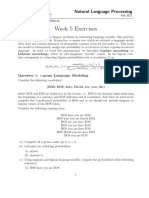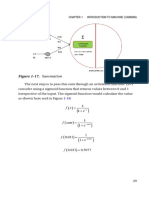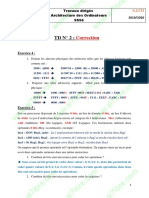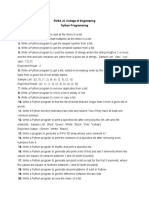Python Code
Uploaded by
Naresh MallireddyPython Code
Uploaded by
Naresh Mallireddyimport numpy as np
class NeuronLayer():
def __init__(self, number_of_neurons, number_of_inputs_per_neuron):
self.synaptic_weights = 2 * random.random((number_of_inputs_per_neuron,
number_of_neurons)) - 1
class NeuralNetwork():
def __init__(self, layer1, layer2):
self.layer1 = layer1
self.layer2 = layer2
# The Sigmoid function, which describes an S shaped curve.
# We pass the weighted sum of the inputs through this function to
# normalise them between 0 and 1.
def __sigmoid(self, x):
return 1 / (1 + exp(-x))
# The derivative of the Sigmoid function.
# This is the gradient of the Sigmoid curve.
# It indicates how confident we are about the existing weight.
def __sigmoid_derivative(self, x):
return x * (1 - x)
# We train the neural network through a process of trial and error.
# Adjusting the synaptic weights each time.
def train(self, training_set_inputs, training_set_outputs,
number_of_training_iterations):
for iteration in xrange(number_of_training_iterations):
# Pass the training set through our neural network
output_from_layer_1, output_from_layer_2 =
self.think(training_set_inputs)
# Calculate the error for layer 2 (The difference between the desired
output
# and the predicted output).
layer2_error = training_set_outputs - output_from_layer_2
layer2_delta = layer2_error *
self.__sigmoid_derivative(output_from_layer_2)
# Calculate the error for layer 1 (By looking at the weights in layer
1,
# we can determine by how much layer 1 contributed to the error in
layer 2).
layer1_error = layer2_delta.dot(self.layer2.synaptic_weights.T)
layer1_delta = layer1_error *
self.__sigmoid_derivative(output_from_layer_1)
# Calculate how much to adjust the weights by
layer1_adjustment = training_set_inputs.T.dot(layer1_delta)
layer2_adjustment = output_from_layer_1.T.dot(layer2_delta)
# Adjust the weights.
self.layer1.synaptic_weights += layer1_adjustment
self.layer2.synaptic_weights += layer2_adjustment
# The neural network thinks.
def think(self, inputs):
output_from_layer1 = self.__sigmoid(dot(inputs,
self.layer1.synaptic_weights))
output_from_layer2 = self.__sigmoid(dot(output_from_layer1,
self.layer2.synaptic_weights))
return output_from_layer1, output_from_layer2
# The neural network prints its weights
def print_weights(self):
print (" Layer 1 (4 neurons, each with 3 inputs): ")
print self.layer1.synaptic_weights
print ( " Layer 2 (1 neuron, with 4 inputs):")
print self.layer2.synaptic_weights
if __name__ == "__main__":
#Seed the random number generator
random.seed(1)
# Create layer 1 (4 neurons, each with 3 inputs)
layer1 = NeuronLayer(4, 3)
# Create layer 2 (a single neuron with 4 inputs)
layer2 = NeuronLayer(1, 4)
# Combine the layers to create a neural network
neural_network = NeuralNetwork(layer1, layer2)
print "Stage 1) Random starting synaptic weights: "
neural_network.print_weights()
# The training set. We have 7 examples, each consisting of 3 input values
# and 1 output value.
training_set_inputs = array([[0, 0, 1], [0, 1, 1], [1, 0, 1], [0, 1, 0], [1, 0,
0], [1, 1, 1], [0, 0, 0]])
training_set_outputs = array([[0, 1, 1, 1, 1, 0, 0]]).T
# Train the neural network using the training set.
# Do it 60,000 times and make small adjustments each time.
neural_network.train(training_set_inputs, training_set_outputs, 60000)
print "Stage 2) New synaptic weights after training: "
neural_network.print_weights()
# Test the neural network with a new situation.
print "Stage 3) Considering a new situation [1, 1, 0] -> ?: "
hidden_state, output = neural_network.think(array([1, 1, 0]))
print output
You might also like
- COSC2429 - Intro To Programming Assessment 2 - Sem A 2021: RMIT Classification: Trusted100% (1)COSC2429 - Intro To Programming Assessment 2 - Sem A 2021: RMIT Classification: Trusted3 pages
- Honing Et Al - Without It No Music Cognition, Biology and100% (1)Honing Et Al - Without It No Music Cognition, Biology and9 pages
- 4.2 Regula-Falsi Method or Method of False PositionNo ratings yet4.2 Regula-Falsi Method or Method of False Position15 pages
- 8-Bit Microprocessor: VLSI Architecture Project Report OnNo ratings yet8-Bit Microprocessor: VLSI Architecture Project Report On35 pages
- OA TD2 Correction 2019 2020 - CompressedNo ratings yetOA TD2 Correction 2019 2020 - Compressed3 pages
- Experiment 3: Aim: Generate or Functions Using Mcculloch-Pitts Neural Net by A Matlab ProgramNo ratings yetExperiment 3: Aim: Generate or Functions Using Mcculloch-Pitts Neural Net by A Matlab Program3 pages
- Lab Manual: CSE 421: Artificial Intelligent and Deep LearningNo ratings yetLab Manual: CSE 421: Artificial Intelligent and Deep Learning28 pages
- CCS355 Neural Networks and Deep LearningNo ratings yetCCS355 Neural Networks and Deep Learning142 pages
- Lecture Notes For Combinational Logic CircuitsNo ratings yetLecture Notes For Combinational Logic Circuits25 pages
- Advanced Computer Architecture Test-1 AnswerNo ratings yetAdvanced Computer Architecture Test-1 Answer2 pages
- Unit - I Difference Between Microprocessor and MicrocontrollerNo ratings yetUnit - I Difference Between Microprocessor and Microcontroller30 pages
- OOSE LAB 01 - Introduction and Project DefinitionNo ratings yetOOSE LAB 01 - Introduction and Project Definition4 pages
- Confusion Matrix, Accuracy, Precision, Recall, F1 ScoreNo ratings yetConfusion Matrix, Accuracy, Precision, Recall, F1 Score1 page
- Java Notes (Complete Pre Java and OOPS) PDFNo ratings yetJava Notes (Complete Pre Java and OOPS) PDF215 pages
- Simulation Modeling Lab Report Ankit Pangeni 1No ratings yetSimulation Modeling Lab Report Ankit Pangeni 118 pages
- Intro to Deep Learning final exam IT3320E HUSTNo ratings yetIntro to Deep Learning final exam IT3320E HUST8 pages
- Paths, Rechability and Connectedness (Lecture Notes)No ratings yetPaths, Rechability and Connectedness (Lecture Notes)10 pages
- Experiment-6: AIM-Write A Program To Implement XOR Gate Using Mcculloch-Pitts Neuron. ProgramNo ratings yetExperiment-6: AIM-Write A Program To Implement XOR Gate Using Mcculloch-Pitts Neuron. Program3 pages
- Practical - 7: Aim: Implement A Program That Remove Left Recursion On Given Grammar. Theory: Left RecursionNo ratings yetPractical - 7: Aim: Implement A Program That Remove Left Recursion On Given Grammar. Theory: Left Recursion4 pages
- wei-et-al-2024-white-matter-plasticity-during-second-language-learning-within-and-across-hemispheresNo ratings yetwei-et-al-2024-white-matter-plasticity-during-second-language-learning-within-and-across-hemispheres9 pages
- (Current Topics in Behavioral Neurosciences 15) Ilias Kazanis (Auth.), Catherine Belzung, Peter Wigmore (Eds.) - Neurogenesis and Neural Plasticity-Springer-Verlag Berlin Heidelberg (2013) PDF80% (5)(Current Topics in Behavioral Neurosciences 15) Ilias Kazanis (Auth.), Catherine Belzung, Peter Wigmore (Eds.) - Neurogenesis and Neural Plasticity-Springer-Verlag Berlin Heidelberg (2013) PDF402 pages
- Just Babies: The Origins of Good and Evil: Paul BloomNo ratings yetJust Babies: The Origins of Good and Evil: Paul Bloom2 pages
- Splendours and Miseries of The Brain PDFNo ratings yetSplendours and Miseries of The Brain PDF13 pages
- Emotions Recognition Using EEG Signals: A Survey: Soraia M. Alarc Ao and Manuel J. Fonseca, Senior Member, IEEENo ratings yetEmotions Recognition Using EEG Signals: A Survey: Soraia M. Alarc Ao and Manuel J. Fonseca, Senior Member, IEEE20 pages
- Striedter - 2015 - Evolution of The Hippocampus in Reptiles and BirdsNo ratings yetStriedter - 2015 - Evolution of The Hippocampus in Reptiles and Birds22 pages
- Neurocognitive Perspectives On Emotional Maturity-199No ratings yetNeurocognitive Perspectives On Emotional Maturity-1993 pages
- Dissociation Following Traumatic Stress: Etiology and Treatment100% (1)Dissociation Following Traumatic Stress: Etiology and Treatment19 pages
- Unit 1-Introduction To Psychology Course ContentsNo ratings yetUnit 1-Introduction To Psychology Course Contents5 pages

























































































